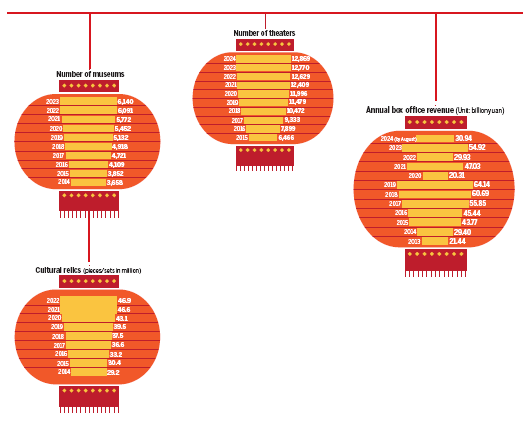

Palaces of relics
In addition to libraries, museums are also playing a prominent role in enriching the public cultural experience.
China has 6,800 registered museums, which attracted 1.29 billion visits last year, and hosted around 40,000 exhibitions and 380,000 public educational events, according to the National Cultural Heritage Administration.
All public libraries, cultural centers, public art galleries, comprehensive cultural stations, and more than 90 percent of museums are open to the public for free.
High-tech solutions have been introduced to improve appreciation of cultural artifacts.
At the Yinxu Museum in Anyang, Henan province, which opened in February, visitors can observe magnified oracle bone carvings at close quarters and can manipulate high-precision 3D models of the bones on screen to examine the details of their strokes.
A digital poster outside the gallery adds to appreciation, by giving visitors access to detailed interpretations of oracle bone scripts, as well as allowing them to take part in a short quiz to put their knowledge to the test.
Small and medium-sized cultural spaces have also made their presence felt.
In Zhejiang province, local authorities have launched a cultural infrastructure project that involves an investment of 10 billion yuan.
The goal is to create a network of "life circles for culture" offering services like museums, stages and gyms within a 15-minute walk of all residents.
More than 11,000 circles now exist, and more are being set up in farther-flung areas, leading to the creation of a host of rural museums, urban bookstores, and cultural centers.
In the Guangxi Zhuang autonomous region, comprehensive culture centers — compounds that provide accessible cultural services — cover 99.6 percent of villages, effectively boosting public cultural service capacities at the grassroots level.
They have greatly broadened the reach of cultural services, making them more convenient for people to access and to experience, said Li Guoxin, a professor with the Department of Information Management at Peking University.
At the same time, cultural facilities around the country have introduced extended hours and staggered services, making it easier for the public to engage in cultural activities, Li said.
He proposed establishing mechanisms for direct access to cultural resources at the grassroots level nationwide, improving mechanisms for social forces including companies and individuals to participate in public cultural services, and promoting reforms that separate the ownership and usage rights of public cultural facilities, and classifying and advancing internal reforms of cultural institutions.
The next task is to focus on strengthening the systemic, integrated, and coordinated nature of these reforms, and optimize the supply of public cultural services and products, Li said.
He also called for the effective integration of technology and talent in cultural development and system reform.